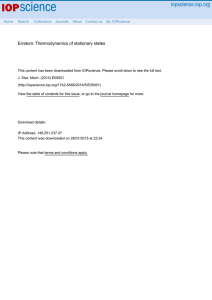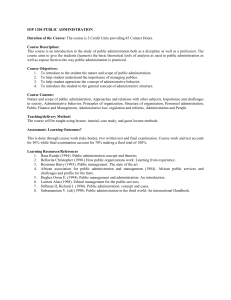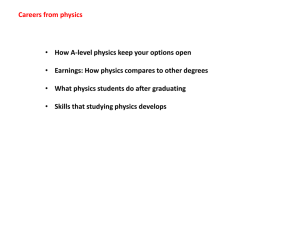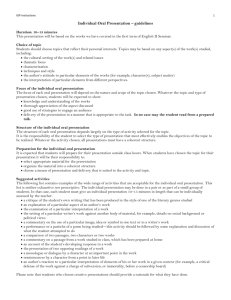IOP Powerpoint Romig Carlyle
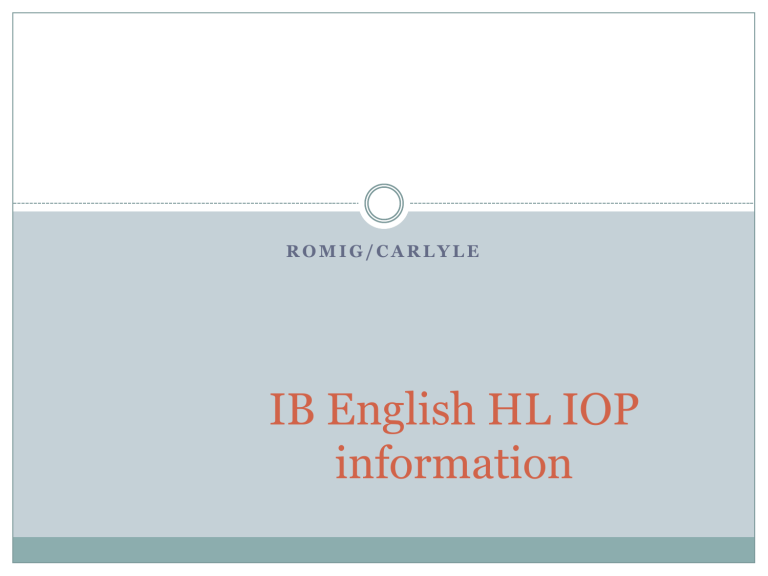
R O M I G / C A R L Y L E
IB English HL IOP information
What is the IOP (Individual Oral Presentation)?
The IOP is a 10-15 minute presentation based on a work or works studied this semester (Part 4 of the syllabus) and brings new ideas to the class, despite the fact that we studied the piece as a group.
Students will present during an assigned time slot
During the actual presentation, teachers must allow students to do their presentations without any interruption or assistance.
Presentations are delivered to the entire class. ALL students must be asked questions from the teacher and classmates at the conclusion of the presentation
IOP Basics continued……
An internal assessment, meaning only your score is submitted to IB
Accounts for 15% of your total IB Points for IB
English (combined with IOC Sr. Year for Oral
Components=30%)
Teacher assistance is minimal through this process, but is allowed for certain aspects
No two people are allowed to have the same topic
Choice of Topic
Students should choose topics that reflect their personal interests. Topics may be based on any aspect(s) of the work(s) studied, including:
• the cultural setting of the work(s) and related issues
• thematic focus
• characterization
• techniques and style
• the author’s attitude to particular elements of the works
(for example, character(s), subject matter)
• the interpretation of particular elements from different perspectives
Consider This
Your idea might come from these areas, or a combination of them. It’s important to remember, however, that the topic should be fairly defined and specific, so that you get a chance to demonstrate detailed understanding of the work and a degree of independent thinking.
Wording Your Topic
Select a topic that is tightly focused.
For example, not just “Race and Gender” in the novel studied but “How racial hierarchy is set up in (novel) and its impact on gender.”
Rather than “Power Relations” you could say “How different characters’ power is presented through the use of language.”
Or- instead of “Death and its consequences”- The way in which death impacts other characters/events/etc.
You get the idea- word it specifically
Focus of the IOP:
The focus of each oral presentation will depend on the nature and scope of the topic chosen. Whatever the topic and type of presentation chosen, students will be expected to show:
• knowledge and understanding of the works
• thorough appreciation of the aspect discussed
• good use of strategies to engage an audience
• delivery of the presentation in a manner that is appropriate to the task.
Structure of the IOP:
The structure of each oral presentation depends largely on the type of activity selected for the topic.
It is the responsibility of the student to select the type of presentation that most effectively enables the objectives of the topic to be realized. Whatever the activity chosen, all presentations must have a coherent structure
This is inevitably up to you, and will depend on the type of presentation you intend to deliver, as well as what you intend to say.
If you are relying on PowerPoint, then it is likely that the slides will provide you with a fairly coherent sequencing of ideas. If you are varying your presentation more, for instance introducing an element of performance or some other kind of “creative” ingredient, then your presentation might be broken into different sections.
Whichever method you choose, it is important to organize your ideas carefully.
Some will follow a very logical sequence (like an expository comparison), but a role play or creative idea might not be suited to that same kind of rigid structure.
Once I choose a topic, how do I present it?
Then, once you have a focus, select activities that will
help you illustrate the focus / explore the topic. A great activity may draw your audience into your topic, but remember, the focus of the IOP is NOT the activity or the gimmick. According to IB, “depending on the activity chosen, students are able to convey their knowledge and understanding of the work through the skills of close detailed analysis, extensive reading, and productive manipulation of content or subject
matter in ways that could be considered creative.” The following are suggestions of activities that would be acceptable, but this list is only a starting point. You DO
NOT have to do a creative delivery; straight forward, lecture style, literary analysis is also acceptable.
Oral Exposés
An introduction to a writer, a work or a particular text
(no reports, though)
And explanation of a particular aspect of an author’s work using additional texts by that author
The examination of a particular interpretation of a work
– criticism with which you disagree to argue against
The setting of a particular writer’s work against another body of material, such as details on social background or political views
A commentary on the use of a particular image, idea or symbol in one text or in a writer’s work
A comparison of two passages, two characters, or two works
Role Play (a rationale for the role play must be included in the presentation)
A monologue by a character at an important point in the work
Reminiscences by a character from a point in later life
An author’s reaction to a particular interpretation of elements of his/her work in a given context. For example, a critical defense of the work against a charge of subversion or immorality, before a censorship board.
A dialogue between two characters from different works, discussing their contrasting motivations
A dialogue between two characters from the same work who do not meet within the work
A dialogue between two characters from the same work explaining their behavior
A dialogue between two characters from different texts from different eras, discussing a particular issue
An author interviewed by the student
An author interviewed by one of his/her characters
The trial by jury of a character who has committed a crime
A section from a novel in dramatic form
Writing and performing an extra scene for a novel
Preparing for the IOP
Practice, Practice, Practice. Your IOP should be a professional and polished reflection of your knowledge of the work. Time yourself – you must present for a minimum of 8 minutes – your goal is 10 minutes. Refer to the rubric to see how you will be scored.
Rehearse your presentation, again and again, and TIME IT.
Microwave timers are really handy, and you will sound really smart to your parents and siblings (and pets, pillows, shoes, etc.
The point is rehearse as much as possible to whomever/whatever you can).
If you can stand it, record yourself presenting and listen to it to critique yourself and find places you want to work on
It may even be helpful to make a list of questions you MIGHT be asked at the end of your presentation and prepare proper responses so you are not lost for ideas when questions are asked
Logistics
It is expected that students will prepare for their IOP outside class
hours. When students have chosen the topic for their presentation, it will be their responsibility to select appropriate material for the presentation, organize the material into a coherent structure, and choose and rehearse the linguistic register appropriate for the presentation. To help you prepare, guidelines have been set up as follows:
You may NOT change a presentation date
Once a topic is selected and approved by your teacher, it cannot be claimed by another student
PRIOR to the IOP, students must meet with their teacher for a conference discussing the plans for the IOP. The IOP planning sheet/outline must be thoroughly completed before the conference meeting.
Teachers may also request an outline of the IOP after the initial conference that shows not only the structure and coherence of the presentation, but also shows content (process points given).
At the time of the IOP, students must turn in an annotated bibliography of sources they used during their IOP research/preparation. Remember, your main source for ANALYSIS should be your own brain!
Students can only do one IOP; it cannot be re-done for a higher grade.
If you decide to do a PowerPoint….
Do not attempt to write everything you want to say on a slide. There is no point reading from the slide because your audience will quickly switch off.
Your voice is far more interesting.
When you use bullet points, only use a few. Lots can be distracting and too text heavy.
PowerPoint works well with pictures and photographs to reinforce your idea, but avoid distracting irrelevant pictures that aren’t connected to what you’re saying and lower the credibility of your presentation.
Avoid making use of highly-contrasting colors, distracting templates, and the more extreme features of animation. They will be fun, but they will detract from your content and professionalism.
Do not use lots of slides: a handful of well-chosen, well-designed slides will be better. The recommended number of slides is about 1-2 per minute of your presentation.
Font: Avoid a non-standard font (especially one that is hard to read) and avoid using font that is smaller than 18.
Remember, PowerPoint is a VISUAL TOOL, not a SCRIPT or
PRESENTATION SUBSTITUTE!
Regardless of Presentation Method
Prepare your talk well. You will not have to memorize it completely, but a few glances at your notes from time to time are all you should need.
Structure is very important. Outline your presentation ideas before choosing a presentation method. Transition smoothly from point to point. Should have 3 basic parts: an intro explaining what you will do and why and basic overview of idea to be presented, the performance or presentation itself, and a thorough justification/explanation of the connections between the presentation and the work.
Variety is key. Use a variety of presentation methods
(discussion, video clips, audio clips, quotations, images, writing, etc.) to engage your audience.
Speak slowly and clearly.
Eye contact: look at people in the audience as much as possible.
Keeping it Interesting
In addition, you will be assessed on your presentation skills.
You are expected to demonstrate care with the choice and execution of your presentation and, perhaps most importantly, an ability to engage your audience. Of all people, you as a student are in a very good position to know what counts for effective presentations. Every day of your school life you will see either teachers or students or both
“presenting” things, and you will know the kinds of strategies that work, as well as ones that don’t. You may well have a highly-interesting topic written out in the appropriate tone with an intelligent command of language and detail, but if you stand in front of the class and simply “read it out” from cue cards, it is unlikely that you will be able to gain top marks.
Therefore, the assessment demands careful thinking, time to prepare and PRACTICE.
Just when you think you are done…..
When the presentation is completed teachers may engage in a discussion with students in order to probe further into their knowledge and understanding of the work(s) or topic. Teachers should be satisfied that students have justified their selection of:
• the material used in the presentation
• the activity chosen to convey the topic
• the suitability of the style of presentation.
The whole class may participate in the subsequent discussion. The student is, however, only assessed on the presentation (which includes the rationale where appropriate).
Criterion A:
Knowledge and understanding of the work(s)
How much knowledge and understanding does the student show of the work(s) used in the presentation?
Mark Level Descriptor
0
1-2
3-4
The work does not reach a standard described by the descriptors below
There is little knowledge or understanding of the content of the work(s) presented.
There is some knowledge and superficial understanding of the content of the work(s) presented.
5-6
7-8
9-10
There is adequate knowledge and understanding of the content and some of the implications of the work(s) presented.
There is very good knowledge and understanding of the content and most of the implications of the work(s) presented.
There is excellent knowledge and understanding of the content and the implications of the work(s) presented.
Rubric-
Criterion B:
Presentation
How much attention has been given to making the delivery effective and appropriate to the presentation?
To what extent are strategies used to interest the audience (for example, audibility, eye contact, gesture, effective use of supporting material)?
Mark Descriptor
0
1-2
3-4
The work does not reach a standard described by the descriptors below.
Delivery of the presentation is seldom appropriate, with little attempt to interest the audience.
Delivery of the presentation is sometimes appropriate, with some attempt to interest the audience.
5-6
7-8
Delivery of the presentation is appropriate, with a clear intention to interest the audience.
Delivery of the presentation is effective, with suitable strategies used to interest the audience.
9-10 Delivery of the presentation is highly effective, with purposeful strategies used to interest the audience.
Rubric-
Criterion C:
Language
How clear and appropriate is the language?
How well is the register and style suited to the choice of presentation? (“Register” refers, in this context, to the student’s use of elements such as vocabulary, tone, sentence structure and terminology appropriate to the presentation.)
Mark Descriptor
0
1-2
3-4
The work does not reach a standard described by the descriptors below.
The language is rarely appropriate, with a very limited attempt to suit register and style to the choice of presentation.
The language is sometimes appropriate, with some attempt to suit register and style to the choice of presentation.
5-6
7-8
9-10
The language is mostly clear and appropriate, with some attention paid to register and style that is suited to the choice of presentation.
The language is clear and appropriate, with register and style consistently suited to the choice of presentation.
The language is very clear and entirely appropriate, with register and style consistently effective and suited to the choice of presentation.
P roper
P reparation
P revents
P athetically
P oor
P erformance
Remember the 6 P’s
Put lots of thought into this and make it a priority. Unlike MOST
IB assessments you will have, you get to pick your topic and presentation method, so make it interesting and make it your own.
Sad, but true.
Some tips from ACTUAL IB Students:
1) don’t do it the night before.
2) engage the audience. try to memorize your speech, give eye contact, speak loudly, use voice inflection— all those presentation skills.
3) make sure you reach your required time.
4) make sure your thesis is clear and concise.
5) if you use a PPT, do not make blocks of text or become too dependent on it.
6) generally, being able to “freestyle” instead of depending on your notes shows that you understand the content and know how to express it.
7) the IOP can be very similar to an essay so make sure that throughout your presentation you keep referring back to your thesis. Since this is an oral presentation, a little repetition helps the audience to remember the main core of your presentation.
8) do not find existing analysis and use it as your own. You will not sound smart to your teacher and classmates; you will sound blatantly plagiarized and embarrassingly dumb.
Tips from students continued….
9) “Record yourself and critique/score it (or in my case count the number of umms; in one IOC practice I had 94 in 5 min).”
10) For the questions your teacher and/or classmates ask at the end of your
presentation: “These questions are not made to trick you, they are used to tease out those last remaining pieces of information that YOU HAVE (just didn’t say or need to clarify) ….can easily pull you up two or three marks and improve areas where you may have received weak points.”
11) Practice! Plan it all out, pace yourself, and know where you will be standing so you don’t block anything you want the audience to see.
12) Do not simply read note cards. You might want to memorize your speech, but this is not required. Remember, this assessment is an oral activity, not a read/written activity. You must work to sound naturally articulate. This means no language fillers (uh, like, and stuff, etc) and appropriate register.
13) Use the text! Quotations / support from the text is required. You do not need to memorize quotations, but they must be part of your presentation.
14) Be precise in your language. Call the work a “novel,” not a “book.” Know your literary terms. Use them. Love them.
15) Test out all technical needs (computer files, etc.) BEFOREHAND.
16) Make sure your interpretation or creative piece and analysis are clearly connected. Your presentation should be cohesive, unified and focused.
On the day of your IOP….. (from a student)
Get to school early and avoid unreliable transportation if possible
Have a good breakfast
Avoid people who you know will be freaking out.
Read through presentation notes
Print off all the stuff you need to the night before (including PWPT slides)
(don’t wait to print at school)
Remind your parents to make sure you get up by a certain time
Put your PowerPoint on a USB, and email it to yourself, your teacher, and maybe another person as well.
Be respectful of others while they are presenting and answering questions; they are going through the same nerves and emotions as you
Stay relaxed and calm
After you have presented, don’t freak out others who haven’t
Remain confident and make sure you don’t speak too fast or too slow
Have fun!
An incentive that is always a possibility for motivation purposes is to have a bet against a friend over the results. It adds some rivalry for people who perform
better with that.
Have a drink of water prior to it to alleviate nerves and get rid of a dry throat
Make eye contact around the room, but avoid people who, intentionally or unintentionally, will try to make you laugh or mess you up. They are your points, not theirs


